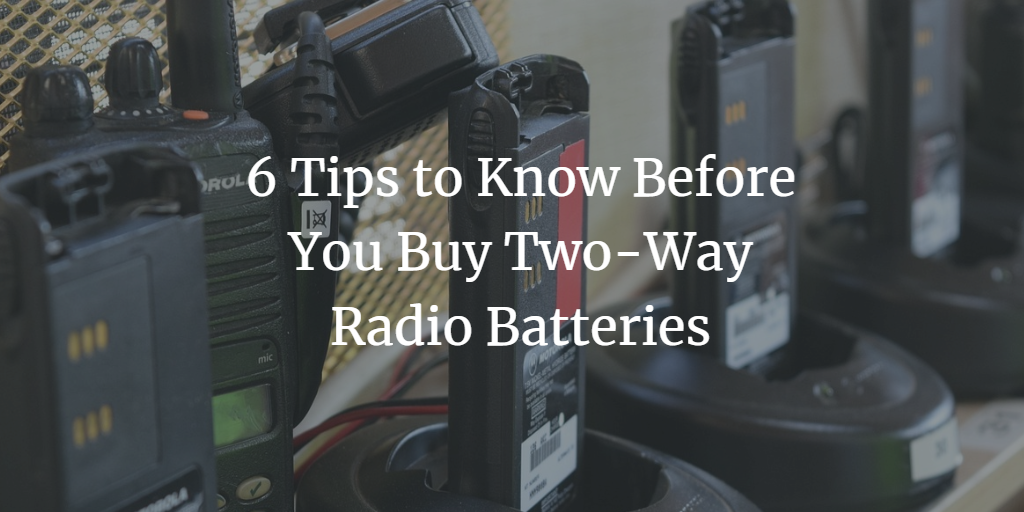Before purchasing two-way radio batteries, it is important to be aware of some essential information. Here are 6 valuable tips to help you acquire the optimal battery.
- Use high capacity batteries
- Use Lithium Chemistry batteries
- Batteries should offer about 300 to 500 charge cycles
- Don’t shy away from aftermarket batteries
- Select the ideal battery for your application
- Read the warranty
Tip #1: Use Higher Capacity Batteries for a Better Run Time Between Charges
Batteries have Milliamp Hours (Mah) which describes the battery capacity or how long your battery will last before it needs to be recharged. To put it simply, the higher the Mah hours the better and longer the battery will run between charges. A battery with 3000 Mah capacity will give you a longer run time than 1000 Mah.
Although higher capacity batteries are more expensive, you’ll get longer run times which is perfect for keeping your radio powered all shift.
Tip #2: Use Lithium Chemistry for Your Batteries
Lithium Ion and Lithium Polymer batteries don’t have memory effect. Batteries have memory and when you charge your battery before completely depleting, the battery remembers that charge cycle the next time.
In other words, if you charge your battery to 80% your battery over time will remember this charge cycle and won’t bring it back to a full charge (100%).
Memory effect decreases battery life and shortens operating time. When buying batteries go for lithium-based chemistries to avoid memory effect.
Tip #3: Batteries should offer about 300 to 500 charge cycles.
With good charging practices and care, radio batteries will last 12 to 24 months. A charge cycle is how many times a battery can be recharged in its lifetime and gives you an idea of expected life. Every time you fully recharge the battery that equals 1 charge cycle. When shopping for batteries go for ones that have at least 300 charge cycles. The more charge cycles the longer life expectancy.
Tip #4: Don’t shy away from aftermarket batteries
While it’s often said you shouldn’t use aftermarket/ off brand radio batteries, we’re here to tell you it’s okay. Many times, aftermarket batteries utilize the same components as OEM and are even compatible with OEM chargers.
For the best performance with aftermarket batteries use the same battery components suggested for your radio. If your radio is designed to run its best on a lithium chemistry, stick to lithium-based batteries.
Tip #5: Select the ideal battery for your application
While secondary rechargeable batteries are the most popular choice for radios, two other kinds of batteries primary (non-rechargeable), and intrinsically safe are available.
Primary batteries are non-rechargeable. Once the battery is depleted it cannot be recharged and used again. These are great to use when access to a charger is limited such as during natural disasters or to keep on hand to swap out batteries on the go.
If you’re using a radio near fire or other hazardous areas, intrinsically safe batteries (IS) are used to protect against fire or explosion. These are mainly used by firefighters, oil refineries, and more. IS batteries are tested and certified by laboratories like FM approvals and UL laboratories for authorized use in hazardous environments. If needing intrinsically safe batteries look for batteries with acredited certifications and that follow IS classifications.
Tip #6: Read the warranty policy.
Although it’s rare batteries can have manufacturing defects. If you do get a defective battery, you’ll want to make sure you’re covered under warranty. Batteries should have at least a 1-year warranty against manufacturing defects. Normal wear and depletion are typically not covered under warranty.
Bonus Tip: Try Waveband Batteries
Let us help you find the right battery for your two-way radio. Here at Waveband Communications, we manufacture aftermarket batteries that are made with the same components found in OEM and work with Motorola, Harris, Kenwood, BK Technologies, and ICOM radios. Our batteries have a less than 1% return rate backed with a 1 year manufacturing defect warranty.



